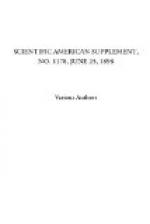I have dwelt thus at length on the question of interest cost in operating a central station system, not alone for the purpose of pointing out to you its importance in connection with an electrical distribution system, but also to impress upon you its importance as a factor in cost; in fact, the most important factor in cost in any public service business which you may enter after leaving this institution. Most of the businesses presenting the greatest possibilities from the point of view of an engineering career are those requiring very large investment and having a comparatively small turnover or yearly income. Of necessity, in all enterprises of this character, the main factor of cost is interest, and if you intend following engineering as a profession, my advice to you would be to learn first the value of money, or, to put it another way, to learn the cost of money.
Before leaving this question of interest and its effect upon cost, I would draw your attention to the fact that while interest is by far the most important factor of cost, it is a constantly reducing amount per unit of maximum output in practically every central station system. When a system is first installed, it is the rule to make large enough investment in real estate and buildings to take care of many times the output obtained in the first year or so of operation. As a rule, the generating plant from the boilers to the switchboard is designed with only sufficient surplus to last a year or so. In the case of the distributing system the same course is followed as in the case of real estate and buildings, with a view to minimizing the ultimate investment. Mains are laid along each block facing, feeders are put in having a capacity far beyond the necessity of the moment; consequently interest cost is very high when a plant first starts, except, as I have stated, in the case of the machinery forming the generating plant itself. As the business increases from, year to year, the item of interest per unit of maximum output consequently will constantly decrease, owing to the fact that each additional unit of output following an increase of connected load increases the divisor by which the total interest is divided. The result is from year to year the interest cost of each additional unit of maximum output is a constantly reducing amount, and consequently the average interest cost of each unit of maximum output should, in a well regulated plant, grow less from year to year until the minimum interest cost per unit is reached. This minimum interest cost is reached when the capacity of the whole system and the total units of output at maximum load are identical, although of course it will always be necessary to have a certain margin of capacity over possible output, as a factor of safety.




